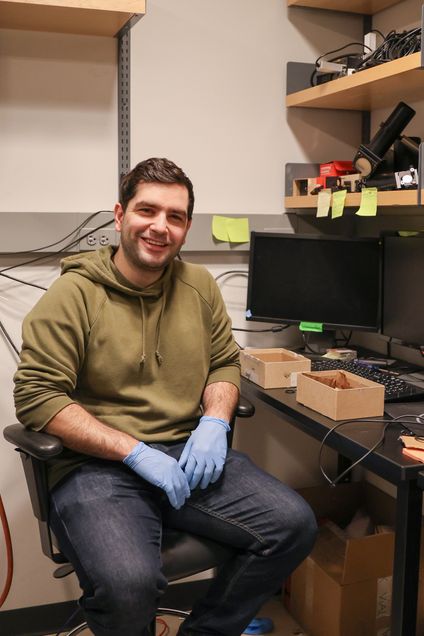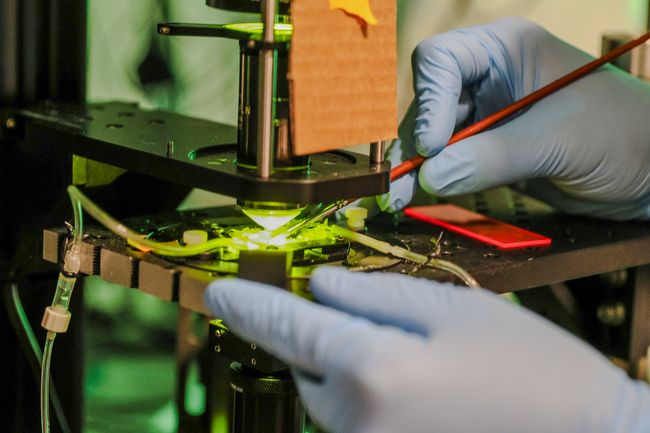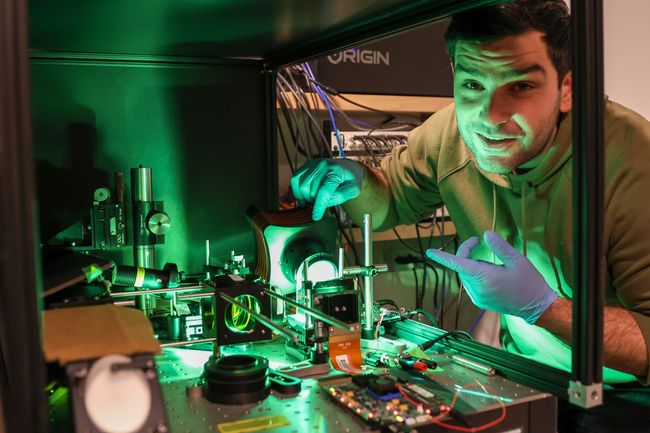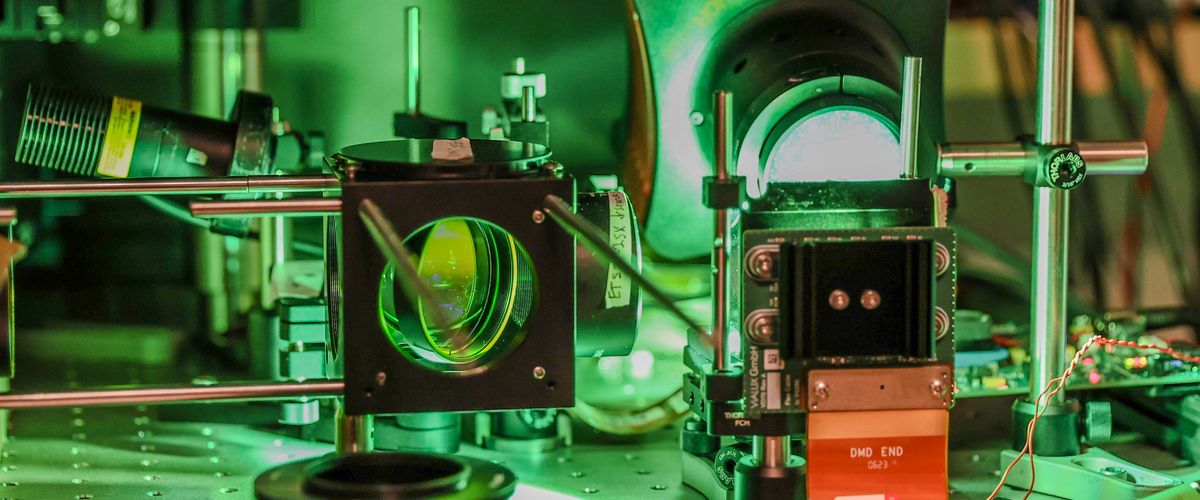Will Cunningham Makes Moves on NPC Graduate Student Organization and Neuronal Circuitry Research
Will Cunningham doesn’t just study how neuronal circuits control systems of movement––he’s making several moves of his own. While pursuing his PhD at Boston University, he’s serving as a member of the Economo lab group, and simultaneously helping to found the Neurophotonics Training Organization (NPTO), a student chapter that will house individual student groups under one umbrella.
For being such a leader in the neurophotonics community, it’s a surprise he wasn’t initially heading down that path. “My STEM journey has been a little winding,” Cunningham says. “Historically, when you think about names that transcend across all borders, scientists are the ones doing the things that transform the world in positive ways.”

Growing up in a house of scientists, Cunningham always had an interest in STEM subjects, but was unsure about his own career path. He studied Mathematics and Computational Science in his undergraduate career, and later worked as a software developer at Epic Systems, where he yearned for a return to academia.
“It was not for me,” Cunningham jokes. “I enjoy learning, and I enjoy interacting with people who are really smart and continuing to grow.”
Deciding to pursue intellectual curiosities that might help better the world, he began studying through the Graduate Program for Neuroscience, following in the footsteps of his mother, a fellow neuroscientist. He even found a way to bring his undergraduate interests into the fold, as he found plenty of space for math and computer science in a number of neuroscience studies. Joining the Economo lab, therefore, was a perfect convergence of his interests.
“The Economo lab as a whole is pretty interested in motor control,” Cunningham says. It’s something most people take for granted. The underlying structure––or “building blocks,” as Cunningham puts it––of what dictates the body’s ability to move and control said movement, made up of neuronal circuits and cell types. By gaining a greater understanding of their function, the Economo lab hopes to provide a deep understanding of how these circuits typically function, providing a baseline for brain-computer interface development or for comparison when things go awry, such as in neurodegenerative diseases.
Cunningham’s role within the group currently involves imaging transcriptomic markers––the things that determine which genes are expressed in each type of cell––via slice work to see how variable the cell types are, and how they work together. “Within a brain region you have a hundred or so building blocks, maybe,” he says. “What are the motifs or themes about the way those building blocks are connected to each other to create ways of doing computation?”

The answer lies in his optical research, studying mice brain cells and keeping them activated to investigate how one activated cell affects the other cells within a single “slice” of a mouse brain. By using proteins––some which activate the cells when exposed to light, some which change in response to cellular activity––Cunningham is able to record the responses of each cell and map out how they talk to each other. Combining this with imaging which proteins each cell expresses allows the lab group to identify cell types and determine what sort of building blocks they are, and thus what function they play in overall movement.
“A lot of what I’m doing is working on the tools for other neuroscientists to get at the things that they’re interested in,” Cunningham explains. Other lab members work to similar ends; for example, one lab member is studying the neuronal circuit for facial movements, gaining a more developed understanding of the brain regions and cells to help specify treatments. “If [scientists] have a good understanding of the underlying connectivity and the way these building blocks are put together, eventually [they] can target individual cell types––because right now a lot of therapies target the whole brain.”
The long-term goal of the Economo lab builds upon the opportunity to advance the understanding of underlying neuronal connectivity, spreading to larger research projects both at BU and beyond. And assisting a larger community of research doesn’t stop for Cunningham in the lab. He’s also working with Neurophotonics Center faculty and staff to create a student-led organization.
With the assistance of professors David Boas and Michelle Sander over the course of the last six or seven years, several student groups have emerged in the effort to bolster community among graduate students. However, there has been no concerted effort to house these groups under one umbrella, giving grad students not only a voice in the community, but easy access to all of their goings-on.
“There’s a symposia group, there’s a neuroethics group,” Cunningham says, listing some of the many committees within the NPC, “more recently there’s even a BCI (Brain and Computer Imaging) group––there’s a podcast group. And so all of these were very disparate committees. They weren’t really talking to each other.”

As the NPTO comes together, Cunningham is hoping to unify these groups, making socialization and collaboration more fluid and frequent. “When Neuroethics has a speaker over, it would be potentially beneficial to have the podcast committee invite that speaker to be interviewed,” he explains, providing further examples of convergent planning. “It might make sense for the BCI committee to have a joint event with the neuroethics committee… It really makes sense for people to talk together and have a community.”
The NPTO brought together the committees at the end of the 2024 fall semester to discuss each committee’s current responsibilities and impact, with the goal of building up the structure of shared resources.
“How do we order food? How do we submit receipts? What rooms should we reserve for our events?” These are some of the shared concerns of the many committees the NPTO hopes to create a baseline of assistance for, promoting further engagement and an easier production process for community events.
At the end of the day, the goal is to create a community for NPC trainees. Promoting their own growth and interests, in Cunningham’s opinion, is the best way to not only forge a sense of collaboration, but to teach.
“Everyone as a grad student knows something that you don’t. That’s part of the point of grad school––everyone’s reading and doing their own research.”
While searching for the strongest leadership and structure of the committees going forward, Cunningham hopes that students who are part of the organization feel that they are getting the most out of their membership, and that their voices are being heard.
“The first thing I did before [our first meeting] was set up a Slack for all of these different groups so that there was one place where the committees could talk about upcoming events and create a Google calendar and a Google Drive for sharing all of those resources.” The NPTO is also planning to begin a newsletter to send out events on a regular basis and create a stream of “familiar faces” as the organization forms a more cohesive structure.
“There is a place for all of these committees to advertise their events, and [Neurophotonics Center students] can expect to become more engaged and involved.”

